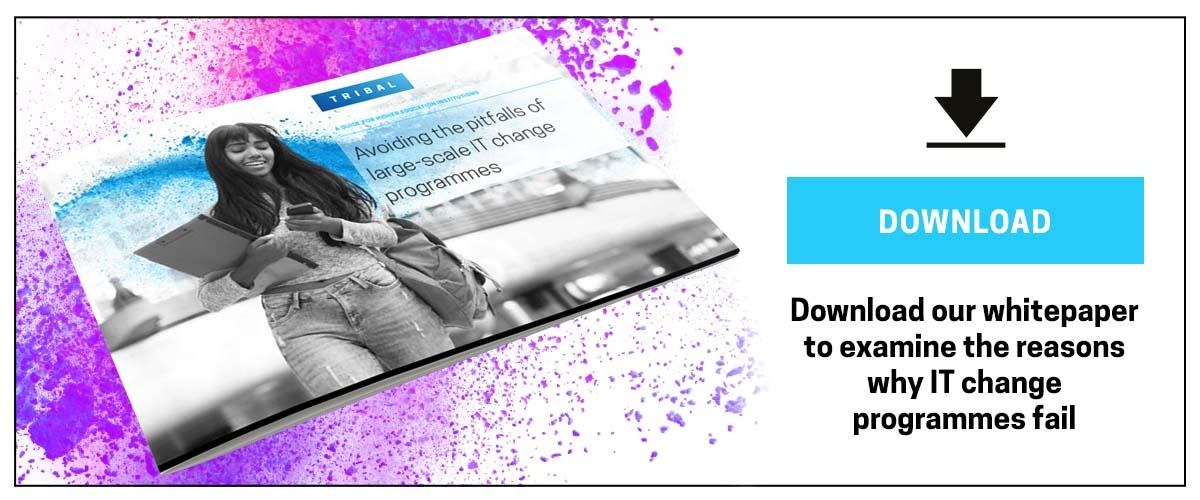The competing demands and stress leading up to go-live can leave any good project manager wondering ‘what have we forgotten?’ It is not unusual for a go-live decision to be based on compromises and an acceptance of a certain amount of risk. But what can be done leading up to this point to assess how ready an organisation is for the change and to address any business or technical readiness gaps?
Validating Business and Release Readiness is a vital activity in the final delivery stages of IT change programmes. A Readiness Assessment is applicable not only when implementing a new Student Information System (SIS), but also when deploying a point solution, a new release or transitioning across to cloud-based modules. The readiness assessment may not be 100% complete until right before go-live, but the planning of what needs to be assessed starts well before this to ensure there is time to address any gaps. And as implementation is at the heart of what we do here at Tribal, we’ve worked with customers to develop a ‘readiness validation’ tool to help identify any gaps and assess their readiness ahead of go-live.
The Business and Release Readiness validation tool covers all the technical elements required to release the new solution, as well as all the business elements required for successful change management. Ultimately owned by the Project Manager, other key project members like the Change and Release Managers can also track their progress and deliverables in this tool, as summarised here:
Release Readiness – being technically ready
There are 15 categories with over 160 assessment items to review and track Release Readiness, which requires input from the Release Manager, Technical Lead, Product Owner, Test Manager and of course the Project Manager.
With such a large scope of activities that need to be completed, without this systematic process or tool, the Project Manager will inevitably open themselves up to the risk of some areas not being fully assessed. From a governance perspective there also needs to be adequate tracking in place to enable informed decisions on proceeding with the go-live.
Business Readiness – focusing on the people side of change
To ensure all the right building blocks for successful change management are in place, Business Readiness validation is typically completed by the Change Manager, Training Manager and Communications Lead.
Key activities like Change Impact Assessments and Change Readiness Assessments will feed into the tool, along with the development of a detailed go-live communications plan. In validating business process changes it is not unusual to uncover areas of the business that had not be considered, or where the full impact was not completely understood by stakeholders. Interim processes may need to be developed to fill any go-live gaps, and in-flight processes will need to be identified to articulate how information will be captured during the freeze period and entered into the new system after go-live. This alongside detailed documentation and training activities makes up the key categories within the tool.
The readiness validation tool identifies high-level categories that contain detailed criteria to be assessed. Each category is assigned an owner who will be required to identify:
- appropriate sign-off criteria
- evidence and/or a deliverable
- who is responsible for signing it off and by when
- a risk rating – meaning criteria can be weighted in terms of potential impact on go-live
- an ongoing assessment of the readiness status of the item – whether items are currently absent, not validated, conditionally validated, or signed-off.
As the tool tracks progress through a set of statuses, it is useful to complete an initial review at the start of the delivery phase. It is completely reasonable that items may not be validated at this stage, but if criteria are currently absent from the delivery plan, then steps to address these gaps need to be swiftly put into place.
Used effectively, this Business and Release Readiness validation tool is proven to:
- save time – it comes with pre-populated categories and criteria based on industry best practice
- give earlier oversight of potential gaps and risks to go-live
- give assurance that all items have been reviewed
- present accurate information to governance groups to enable a go-live decision
- help the Project Manager understand who needs to know what and when.
Gaining assurance through Tribal support
Experience tells us half the challenge of go-live and BAU success is ensuring you have a comprehensive list that minimises the risk of gaps. The other half is thinking about how you can evidence to governance groups that items have been reviewed and signed off. Using the tool helps achieve both these outcomes effectively. And for additional peace of mind, Tribal can supply a service package to deploy and manage the completion of the Business and Release Readiness validation tool for you.
Having used this successfully with our customers, our consultants will be able to guide you through the process and give suggestions of what will be most appropriate. The service can easily be scaled up or down based on the size, complexity or competency of an implementation. We can also help you design your operational support model early in the delivery phase and give recommendations and insights that will help you obtain the organisational buy-in you require.
If you’d like any further information about our Business and Release Readiness validation tool, or the support Tribal can provide to successfully implement your Student Information System, point solution or new release/upgrade – our team would love to hear from you.
In our next blog we’ll discuss one of the most critical items within the Business and Release Readiness tool – gaining buy-in to develop an effective Operational Support Model for BAU.
TOPICS:
SHARE THIS ARTICLE:




